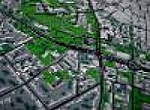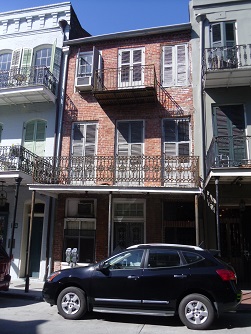Watershed Planning Improves Water Quality, Reduces Floods

Watershed planning is a foreign idea to most people. Most folks don't even stop to consider what watershed or drainage basin they live in, unless they stay right beside a body of water. Even if they happen to know this bit of what may seem like trivia, they certainly do not believe that they can impact an entire watershed that does not follow political or other boundaries. Our purpose right now is to convince you that this is both possible and gratifying.
If you want gleaming lake water like that seen in our photo, some thinking about the contributors to clean water is in order.
Many types of water quality or quantity issues, including pollution from urban runoff, recreation, navigation, or water supply questions, need to be dealt with on a watershed basis.
The U.S. Environmental Protection Agency (EPA) operates this fun web page that allows you to determine what your watershed is and to make contact with any groups that are active in caring for the watershed.
The best flood prevention measures preserve or enhance the watershed's capacity to handle stormwater on a gradual basis, and restore the flood storage capacity of natural floodplains wherever possible. So in many areas, flooding issues drive watershed planning.
Forming and maintaining watershed groups or councils is frustrating work, because the watersheds are often a much different shape and geography than the political subdivisions. However, it's very interesting and rewarding to bond with the people who share a watershed with you. Give it a try.
The U.S. Geological Service monitors stream levels and reports them on the basis of an eight-digit watershed classification system. The USGS provides an on-line map of current flooding or high water locations, as well as additional information you might find useful.
In an urban environment, you probably will need to focus in on a sub-basin that you considerable manageable, given considerations about politics, socioeconomic backgrounds of the various populations, municipal boundaries, and ease of travel. You also may have to fight to get people to understand the importance of this topic when many others seem more pressing. For an example of the attitude you might encounter, see our site visitor's question (and our answer), called are cities part of a watershed?
Rural folks who have a good transportation network can choose to work with a much larger geographic area of hundreds of square miles, providing that land is similar in its use and characteristics.
When you look at the websites and determine what level of watershed planning will be practical for you (a fairly large watershed, or the smallest breakdown of watershed that the U.S. government has established), set up your first watershed planning meeting.
If your neighbors don't care about the local creek or stream (which may be called derisively a ditch or some other pejorative word), perhaps you will have to change your argument at first to talk about the receiving body of water, the one into which your water resource flows. Suddenly at the level of the Colorado River or the Gulf of Mexico, maybe people who live close enough to that river or sea will understand. However, those who live far from the river or gulf will still have a tough time with the idea.
At your first meeting, explain the anti-flooding and anti-pollution benefits of working together as a watershed. Perhaps your goals will be more related to recreation. For example, this would include a lake-oriented tourist economy or somewhere that fishing and swimming in nature is just part of your culture. Some of you who depend on ports will find continuing navigation to be your most convincing challenge.
Begin with whichever argument will be stronger in your area! It's hard enough to keep a typical watershed coalition together, precisely because the people involved may not be accustomed to working with one another at all. Another factor making watershed planning difficult is that the benefits tend to be long-term, and some benefits will never be very visible to the average resident. This work requires abstract thinking, wouldn't you say?
While it's easy to see that watershed planning would work for figuring out where flooding is coming from, and therefore how to prevent it, clean water and other benefits are also important.
If your heavy metals or heavy nutrient load (such as a lot of fertilizer) are upstream (near the source of the river or stream that you're using as the spine of your watershed), you'll only get cleaner and better looking water downstream when the upstream area does a stream clean-up or plans how to better filter stormwater runoff through vegetation or other means before it runs into the creek (stream, bayou, coulee, wash, or whatever you call it in your part of the world).
Organizing the Watershed Plan Itself
When you have met a few times and are ready to think about actually preparing a plan, you have a critical decision to make. If you are U.S.-based, that would be whether you want your plan to be able to serve as the required Section 319 nonpoint source watershed management plan. In other countries, you will have similar considerations about what the national or other level of government requires for funding.
Let's unpack what in the world we mean. Section 319 is just a section of the Clean Water Act. "Nonpoint source" of water pollution simply means that rather than a specific discharge pipe, such as a factory would have had 50 years ago, the pollution is coming from what the rain or snow melt encounters on the way to the water body.
Typically "nonpoint source" would mean the same as stormwater runoff.
The term "management plan" is widely used in environmental regulation to describe how the government or other entity could take steps to manage (increase or decrease) a specific characteristic of the watershed.
If you choose to write a plan that will meet the Section 319 impaired waters standards for funding, you will want to look at the official EPA publication about preparing a watershed plan. It's extensive. This explains the nine required elements of such a plan. The only saving grace is that if what is required already has been written into a previous report, EPA is rather understanding about allowing you to use that earlier work.
This level of planning is definitely something you cannot complete without help from trained specialists. You might be able to convince an expert you lives in the area to help you with enough data collection to complete the watershed planning, but expect that you're going to have to pay for at least some of the work to be done.
Do-It-Yourself Watershed Planning
If you can't see that you would ever be able to find the resources to prepare such an elaborate plan, and if you're sure you won't ever want government implementation money, then you can opt for the simple homemade plan to improve the functioning, or cleanliness, and appearance of the watershed.
Volunteer groups may be able to produce a meaningful plan without the use of baseline measurements, but of course if you can figure out how to afford it, scientific help would be very useful. Often the locals, especially in agricultural or conservation-minded areas, are pretty accurate in their understanding of flooding and such, but sometimes clueless about the microbiology and chemistry of their water.
Your state conservation department or even an Army Corps of Engineers unit nearby might be very willing to help you.
We want to emphasize that probably your situation isn't unique, and that even without one penny of funding, you can create a one-page plan that would make a real difference, if implemented.
To give your planning project some publicity and excitement, plan a series of stream clean-up days. (Use the link to find a form to tell us how you did it; your photos can appear there too.) Be sure to photograph the big mound of stuff you will have pulled out of the streambank or its immediate surrounding area.
Our top two gutsy moves in a positive direction for water quality are:
- Enacting parking maximums instead of minimum parking requirements, and
- Requiring parking lots of more than a certain size to initiate low-impact development.
The parking maximum would serve
to limit the amount of impervious surface, which in turn makes that fast
runoff of rain, where there is no chance for plants to filter out
pollutants, less probable.
We teach people that the meaning of low-impact development is easy to remember. In short, it means that the islands in the parking lot are lower than the surface, rather than higher than the surface, as has been the custom for a number of years. Low-impact development is often abbreviated to LID, by the way.
It's important for large paved areas to drain into an interim location, such as a depressed landscape island dressed up with plants that like their feet wet. This means that when water ultimately seeps into the groundwater supply, it has been filtered of road oils, heavy metals, animal waste, and other stuff we don't like to think about.
So you see, just a simple three-point plan (clean-ups, parking maximums, and low-impact development) could be quite bold and also very worthwhile. Thinking on a watershed scale will require making some new acquaintances, but you will find that over time, some will become friends as you experience the joy of cleaning up your local stream or bay.
Do go over and read the stormwater runoff page (photo link elsewhere on this page) for more easy-to-articulate, tough-to-do ideas that your watershed planning could implement.
Relevant as You Start Thinking of Your Watershed
Join USEFUL COMMUNITY PLUS, which provides you monthly with short features or tips about timely topics for neighborhoods, towns and cities, community organizations, rural environments, and our international friends. Unsubscribe any time. Give it a try.





